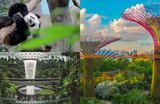Switzerland is the definition of dream-like and picturesque with its Alpine mountains with snowy peaks, glassy lakes, and villages dotted with quaint chalets. It also appears to be perpetually covered in a blanket of snow, making it quite the winter wonderland.
Set to travel to Switzerland for the first time? We’ve crafted a guide with everything you need to know about visiting the snowy European country! Just keep scrolling to learn more:
- When is the best time to visit Switzerland?
- How do I get around Switzerland?
- Should I ride a cable car?
- Where can I stay in Switzerland?
- Where can I eat there?
- How is the water there?
- What is the Via Ferrata?
- What are trail marks in Switzerland?
- Why do I need a universal travel adaptor?
- What languages are spoken in Switzerland?
1. When is the best time to visit Switzerland?
Travelling to Switzerland is fantastic any season of the year! However, each season offers something unique to the table. December to March is ski season, making it ideal for those who want to hit the slopes. July to August, on the other hand, is the peak season for travellers who prefer warmer weather. Thanks to the high altitude of Switzerland there’s also no humidity so you won’t feel like sweating buckets.
2. How do I get around Switzerland?
A great thing about Switzerland travel is that you can easily commute from Point A to Point B with the Swiss Travel Pass. This rail pass has unlimited rides on trains, buses, boats, and premium panorama trains to save you the hassle of buying tickets for every trip.
3. Should I ride a cable car?
What you’ll notice on your travel to Switzerland is that cable cars are really common, especially in its mountains. Not only do they provide mountaineers easy access, but they also provide tourists with a tremendous birds-eye view of the snowy peaks and valleys—which you have to see for yourself!
4. Where can I stay in Switzerland?
Switzerland is home to plenty of palatial hotels and chalets, often boasting of views of the Alps. However, they can be quite pricey. The resort town of Interlaken has plenty of affordable options for accommodations, with rates as low as AUD 55, as well as various mountain trails for nature enthusiasts.
5. Where can I eat there?
Fine restaurants that serve traditional Swiss food such as Raclette (melted cheese with jacket potatoes) and Rösti (hot cake made of grated potatoes) abound in the Alpine country. However, if you’re going to travel to Switzerland on a budget, you can also frequent the farmer’s markets and cafés in the mountains, which are less costly.
Tip: For hassle-free booking, you can book an Interlaken accommodation from Klook!
6. How is the water there?
Tap water in Switzerland is completely safe to drink. If you’re going on city tours and nature trails, you’ll even find drinking fountains and taps. Make sure to bring water bottles or flasks so you can refill them and have a drink in hand throughout your journey!
7. What is the Via Ferrata?
If you’re up for an adventure with a dash of thrill, you can try Via Ferrata, an exhilarating climbing activity that will take you to mountain peaks. Via Ferrata combines rock climbing and going up steps and ladders with safety gear strapped on.
8. What are trail marks in Switzerland?
Nature lovers often flock to the trails of Switzerland for their dramatic views. Along those trails, you’ll find trail markers created by Swiss locals to help hikers and inform them of what’s ahead. Red and white lines mean that the trail is safe for beginners with no climbing expertise, while blue and white indicate an alpine route that requires more experience.
9. Why do I need a universal travel adaptor?
A universal travel adaptor will come in handy during your travel to Switzerland, as the country uses TYPE J outlets (one with three round pins). The rest of Europe uses TYPE F (one with two Earth clips on the side), so you can also use your adaptor should you wish to hop on a train and visit other European destinations.
10. What languages are spoken in Switzerland?
Since Switzerland is a melting pot of cultures and languages, you’ll find many French, German, Italian and Romansch speakers. While it’s less likely to meet locals who speak English, you will find guides in tourist areas and public transportation operators who can speak English.







![[Updated] Complete List Of Official Nationwide MCO SOP 2021](https://res.klook.com/image/upload/fl_lossy.progressive,q_85/c_fill,w_160,h_104/v1633858858/blog/iso56uzsphmdguixkvzh.jpg)





![[Updated] Complete List Of Official Nationwide MCO SOP 2021](https://res.klook.com/image/upload/fl_lossy.progressive,q_85/c_fill,w_410,h_264/v1633858858/blog/iso56uzsphmdguixkvzh.jpg)






